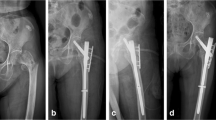Abstract
Purpose
Intramedullary nailing is widely used in the treatment of stable pertrochanteric fractures. However, it remains controversial whether the distal locking with intramedullary nailing is necessary.
Method
In this study, 70 patients over the age of 65 with pertrochanteric fractures (AO/OTA 31-A1 and A2) were enrolled and randomly divided into two groups for treatment by intramedullary nails either with or without distal locking. Intra-operative variables such as operation time, volume of blood loss, total fluoroscopy time, total length of incision, postoperative complications and clinical outcomes were recorded and compared between the two groups.
Results
A total of 29 patients in the locking group and 30 patients in the unlocking group completed one year of follow up. Operation time (39.2 ± 7.6 min), blood loss (158.6 ± 63.6 ml), fluoroscopy time (53.7 ± 3.9 s), and total length of incision (13.1 ± 2.1 cm) in the unlocking group were significantly decreased compared with the locking group (48.5 ± 9.0 min; 194.3 ± 61.6 ml; 57.8 ± 4.3 s; 10.9 ± 1.7 cm) (p < 0.05). No significant differences in postoperative complications and fracture union were identified between the two groups. Most patients in the locking group (80.0 %) and the unlocking group (77.1 %) recovered to their pre-injury activity levels.
Conclusion
This study suggests that intramedullary nails without distal locking may be a reliable and acceptable option for treating stable pertrochanteric fractures (AO/OTA 31-A1 and A2) in elderly people. Distal unlocked nails showed subtle advantages in reducing blood loss, operation time, fluoroscopy exposure time, and size of the incision.



Similar content being viewed by others
References
Burgers PT, Van Lieshout EM, Verhelst J, Dawson I, de Rijcke PA (2014) Implementing a clinical pathway for hip fractures; effects on hospital length of stay and complication rates in five hundred and twenty six patients. Int Orthop 38(5):1045–1050
Zou J, Xu Y, Yang H (2009) A comparison of proximal femoral nail antirotation and dynamic Hip screw devices in trochanteric fractures. J Int Med Res 37(4):1057–1064
Bonnaire F, Zenker H, Lill C, Weber AT, Linke B (2005) Treatment strategies for proximal femur fractures in osteoporotic patients. Osteoporos Int 16:S93–S102
Forte ML, Virnig BA, Kane RL, Durham S, Bhandari M, Feldman R, Swiontkowski MF (2008) Geographic variation in device use for intertrochanteric hip fractures. J Bone Joint Surg Am 90:691–699
Simmermacher RK, Ljungqvist J, Bail H, Hockertz T, Vochteloo AJ, Ochs U, Werken C, Studygroup AP (2008) The new proximal femoral nail antirotation (PFNA) in daily practice: results of a multicentre clinical study. Injury 39:932–939
Mereddy P, Kamath S, Ramakrishnan M, Malik H, Donnachie N (2009) The AO/ASIF proximal femoral nail antirotation (PFNA): a new design for the treatment of unstable proximal femoral fractures. Injury 40:428–432
Radcliff TA, Regan E, Cowper Ripley DC, Hutt E (2012) Increased use of intramedullary nails for intertrochanteric proximal femoral fractures in veterans affairs hospitals: a comparative effectiveness study. J Bone Joint Surg Am 94:833–840
Anglen JO, Weinstein JN, Committee ABoOSR (2008) Nail or plate fixation of intertrochanteric hip fractures: changing pattern of practice. J Bone Joint Surg Am 90:700–707
Skala-Rosenbaum J, Bartonicek J, Bartoska R (2010) Is distal locking with IMHN necessary in every pertrochanteric fracture? Int Orthop 34:1041–1047
Rosenblum SF, Zuckerman JD, Kummer F, Tam BS (1992) A biomechanical evaluation of the Gamma nail. J Bone Joint Surg Br 74:352–357
Ozkan K, Unay K, Demircay C, Cakir M, Eceviz E (2009) Distal unlocked proximal femoral intramedullary nailing for intertrochanteric femur fractures. Int Orthop 33:1397–1400
Maniscalco P, Rivera F, D’Ascola J, Del Vecchio EO (2013) Failure of intertrochanteric nailing due to distal nail jamming. J Orthop Traumatol 14:71–74
Grimaldi M, Courvoisier A, Tonetti J, Vouaillat H, Merloz P (2009) Superficial femoral artery injury resulting from intertrochanteric hip fracture fixation by a locked intramedullary nail. Orthop Traumatol Surg Res 95:380–382
Marsh JL, Slongo TF, Agel J, Broderick JS, Creevey W, DeCoster TA et al (2007) Fracture and dislocation classification compendium—2007: Orthopaedic Trauma Association classification, database and outcomes committee. J Orthop Trauma 21:S1–S133
Hesse B, Gachter A (2004) Complications following the treatment of trochanteric fractures with the gamma nail. Arch Orthop Trauma Surg 124:692–698
Radford P, Needoff M, Webb J (1993) A prospective randomised comparison of the dynamic hip screw and the gamma locking nail. J Bone Joint Surg Br 75:789–793
Valverde JA, Alonso MG, Porro JG, Rueda D, Larrauri PM, Soler JJ (1998) Use of the Gamma nail in the treatment of fractures of the proximal femur. Clin Orthop Relat Res 350:56–61
Bellabarba C, Herscovici D Jr, Ricci WM (2003) Percutaneous treatment of peritrochanteric fractures using the Gamma nail. J Orthop Trauma 17:S38–S50
Hou Z, Bowen TR, Irgit KS, Matzko ME, Andreychik CM, Horwitz DS, Smith WR (2013) Treatment of pertrochanteric fractures (OTA 31-A1 and A2): long versus short cephalomedullary nailing. J Orthop Trauma 27(6):318–324
Vopat BG, Kane PM, Truntzer J, McClure P, Paller D, Abbood E, Born C (2014) Is distal locking of long nails for intertrochanteric fractures necessary? A clinical study. J Clin Orthop Trauma 5:233–239
Lacroix H, Arwert H, Snijders C, Fontijne W (1995) Prevention of fracture at the distal locking site of the gamma nail. A biomechanical study. J Bone Joint Surg Br 77:274–276
Bong MR, Kummer FJ, Koval KJ, Egol KA (2007) Intramedullary nailing of the lower extremity: biomechanics and biology. J Am Acad Orthop Surg 15:97–106
Kane PM, Vopat B, Paller D, Koruprolu S, Born CT (2013) Effect of distal interlock fixation in stable intertrochanteric fractures. Orthopedics 36:e859–e864
Ozkan K, Eceviz E, Unay K, Tasyikan L, Akman B, Eren A (2011) Treatment of reverse oblique trochanteric femoral fractures with proximal femoral nail. Int Orthop 35:595–598
Conflict of interest
The authors declare that they have no conflicts of interest.
Author information
Authors and Affiliations
Corresponding author
Rights and permissions
About this article
Cite this article
Li, X., Zhang, L., Hou, Z. et al. Distal locked and unlocked nailing for perthrochanteric fractures—a prospective comparative randomized study. International Orthopaedics (SICOT) 39, 1645–1652 (2015). https://doi.org/10.1007/s00264-015-2771-1
Received:
Accepted:
Published:
Issue Date:
DOI: https://doi.org/10.1007/s00264-015-2771-1




